The Wingshooting Schools of England: Part 3, The E.J. Churchill Shooting Ground

It takes a special kind of genius to fit a guy with a ladies’ shotgun, teach him a new clays-shooting technique and then get him out on the course to start smashing targets all within the span of 90 minutes.
In late November 2019, when upland fever runs high, Shotgun Life opted for a contrarian trip to the outskirts of London for stops at arguably the best clays grounds in the world. Our experience was a revelation. While American sporting clays has gradually deviated from its origins as off-season wingshooting practice, England’s shooting grounds remain devoutly steadfast in providing simulated wingshooting and instructions for estate and moorlands shoots of pheasants, partridge and red grouse. Despite the proximity to London, the shooting grounds are surprisingly pastoral, sprawling and, of course, suffused with British tradition. We visited James Purdey & Sons’ Royal Berkshire Shooting School, West London Shooting School, E.J. Churchill Shooting Ground, Holland & Holland Shooting Grounds and Atkin Grant & Lang. Join us…
The Wingshooting Schools of England: Part 3, The E.J. Churchill Shooting Ground
Written by Irwin Greenstein
It takes a special kind of genius to fit a guy with a ladies’ shotgun, teach him a new clays-shooting technique and then get him out on the course to start smashing targets all within the span of 90 minutes.
Our man at the E.J. Churchill Shooting Ground was veteran instructor, Adam Davies. He has been associated with the organization since 2005, and in 2018 was officially anointed, with four other hand-picked instructors, a qualified trainer of the George Digweed Method after 18 months of training with the master himself. Mr. Digweed has won some 26 world clays-shooting titles and 150 international clays titles, and along with being an 18-time European Champion, makes him the most decorated athlete on the planet – and yes you do want to learn how to shoot like him.
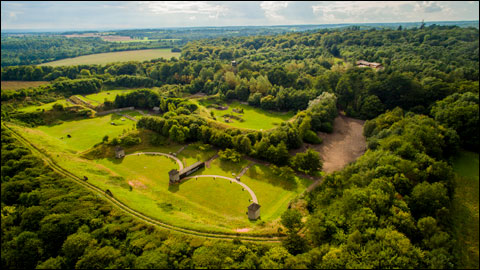 Ariel view of the E.J. Churchill Shooting Ground.
Ariel view of the E.J. Churchill Shooting Ground.Mr. Davies would have two surprises in store for me. First, the venerable Churchill Method of shooting has largely been overshadowed by the George Digweed approach at the E.J. Churchill Shooting Ground. And second, Mr. Davies would fit me with a bona-fide women’s shotgun. Clearly, things were changing at one of England’s most esteemed shooting institutions.
For wingshooting afficionados something may sound fishy about having clays-shooting legend Mr. Digweed align with the E.J. Churchill Shooting Ground – the birthplace of instinctive wingshooting. After all, it was Robert Churchill who developed the Churchill Method of wingshooting that has become a touchstone, notably in America for the Orvis Wingshooting Schools.
According to Churchill, there is no question of trying to compute muzzle movement, forward allowance, or any other complicated matters. All he asks the shooter to do is look at the bird and through correct gun mounting, shoot as naturally as you point with your index finger. Without constraint or effort, you are making contact with and shooting at the bird, but subconsciously swinging through slightly to compensate for flight time.
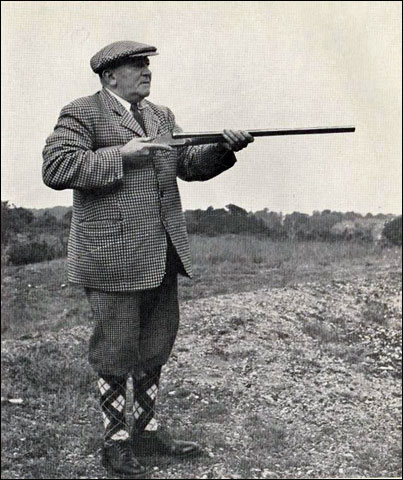 Robert Churchill
Robert ChurchillYou could argue that his “Game Shooting” published in 1955 forever changed the way game birds are hunted. You could also speculate that it’s the first modern method of wingshooting.
Come January 2018, however, the E.J. Churchill Shooting Ground decided to amp things up.
That’s when their George Digweed Academy at the E.J. Churchill Shooting Ground in High Wycombe, Buckinghamshire was launched. Although there is a genuine business motive to the partnership with Mr. Digweed, Rob Fenwick, E.J. Churchill’s Managing Director saw Mr. Digweed’s appointment as E.J. Churchill’s Global Shooting Ambassador as an opportunity to promote competitive clays shooting – in particular the World English Sporting Championship held there in 2014, 2016, 2018 and is now scheduled in 2021.
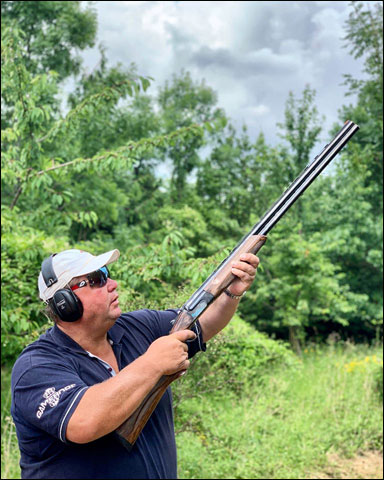 George Digweed
George DigweedThe arrangement with Mr. Digweed shows how the E.J. Churchill Shooting Ground has set itself apart from the others around London by staking claim to high-impact tournaments. In addition to the World English Sporting Championship it has hosted the World Compak Sporting Championship, the Churchill Challenge and the European Side by Side Championship.
When we arrived at the E.J. Churchill Shooting Ground on November 28th at 3:00 pm, I had expected the doctrinaire of Mr. Churchill on the fine art of wingshooting. Apparently, Mr. Davies had other ideas.
As my lesson progressed, I would come to realize that the mash-up of traditional wingshooting instructions on a world-class tournament course somehow electrifies the entire E.J. Churchill Shooting Ground experience. The look is tweed shooting waistcoat with blue denim and a pricy Olympic-grade clays shotgun broken open over the shoulder accessorized with a luxury-branded ball cap. It’s like the casual Friday of British shooting convention, but rest assured that the E.J. Churchill Shooting Ground still teaches the Churchill Method with any number of side by sides in their gunroom.
 The Blaser F16 Intuition shotgun for women.
The Blaser F16 Intuition shotgun for women.Now in the clubhouse gunroom, Mr. Davies eyeballed my 185-pound, five-foot-nine stature, had me shoulder a shotgun that was too long, and then disappeared for few minutes only to return with a 12-gauge Blaser F16 Intuition designed for women. I could only imagine the calculations going through his mind as he looked at the gun racks trying to determine which of them would be best for me.
The Blaser F16 Intuition has a raised Monte Carlo stock is in consideration of women’s higher cheek bones and longer necks – decreasing recoil to the face while perfecting eye/target alignment. The stock’s reduced pitch angle adapts to the breast area, again for lower felt recoil. A shorter length presents superior trigger control while at the same time helping with smooth low-gun mounts. The pistol grip and trigger are reduced for a woman’s smaller hands.
Initially, I was a bit disappointed that we would forego the Churchill Method for my lesson – if no other reason than it was Robert’s Churchill’s uncle, Edwin John (E.J.) whose name hung on the school’s shingle. After all, when we think of the English Shooting School experience we want to be immersed in tradition. Regardless, the shooting ground does have deep roots.
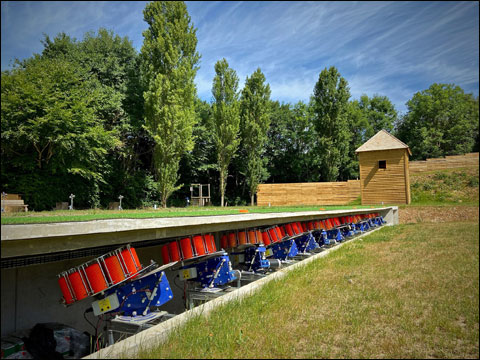 The skeet and Olympic trap field at the E.J. Churchill Shooting Ground.
The skeet and Olympic trap field at the E.J. Churchill Shooting Ground.E.J. Churchill started his company in 1891 as a gunmaking workshop. He had established a premier reputation in London – his business rapidly ascending between the world wars. Meanwhile, Robert Churchill served an apprenticeship to Dorchester gunmaker, Charles Jeffery. Later, he moved to London where he worked for gunmaker, F.T. Baker. While in London Robert Churchill established himself as a top pigeon shooter.
When E.J. died in 1910, Robert took over the company. He deemphasized the longer barrels used by his uncle that were so popular with pigeon shooters of the day, and introduced the now-famous 25-inch barrels with a high tapered rib (which when taking a shot, made the barrels seem longer). In turn, the new Churchill shotguns were marketed as the XXV. Twenty-five-inch barrels worked wonders for Mr. Churchill, who himself was relatively short. Regardless, the shorter barrels made for lively performance in the grouse moors where the Churchill method of shooting excelled.
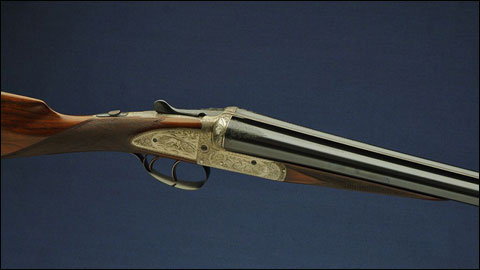 A Churchill XXV.
A Churchill XXV.Robert died in 1958 and E.J. Churchill gunmaker fell victim to the decline of the British gun trade and cheaper Spanish knock-offs. Never quite getting the cash infusion it needed to stay afloat, by 1981 the remaining inventory of nearly 100 sidelocks and boxlocks was put up for auction in Texas. It was the end of an era.
The Churchill marque may have been down but it wasn’t out. In 1997, some 10 years after he started the E.J. Churchill Shooting Ground in High Wycombe, Sir Edward Dashwood purchased the name and record books of the historic gunmaker. This expanded the operation of the shooting ground situated on 40 acres of the 5,000-acre ancestral estate that has been in the Dashwood family since 1698.
 The new Churchill Hercules side by side comes in 12, 16, 20, 28 and .410 bore as singles or pairs.
The new Churchill Hercules side by side comes in 12, 16, 20, 28 and .410 bore as singles or pairs.Through the use of more than 150 shooting stands, three high towers, a skeet field, five grouse butts and a multi-sport field, instructors here have the wherewithal to improve your skills for wing and clays shooting. The E.J. Churchill Shooting Ground asserts that it is the only shooting business in the UK with its own shooting ground, gunmaking facility, sporting agency, country clothing store and events company.
Under Sir Edward’s stewardship, the Churchill shooting legacy has come full circle, albeit it with Churchill branded shotguns made in Italy and Spain that are tended to by an on-site cadre of gunsmiths. Time marches on.
By expecting a lesson in the Churchill Method what I failed to comprehend was the significant shift taking place in the shooting schools around London.
Although Mr. Digweed’s Ambassador role at the E.J. Churchill Shooting Ground addressed the groundswell of notable shooting tournaments there, it also coincided with a seismic shift in the types of shotguns used for the traditional British high driven pheasant shoot. While the old guard adheres to the long-barrel side-by-side, younger hunters are favoring tournament-grade clays shotguns from the likes of Perazzi, Krieghoff and Beretta. To them, the over/under delivers a better sight picture, but even more importantly is that these types of shotguns can really handle the pounding of the heavy target loads that have crept into the sport. If you want proof, look no further than the recent Purdey Trigger Plate over/unders engineered to withstand the punishment of the most powerful shotgun shells.
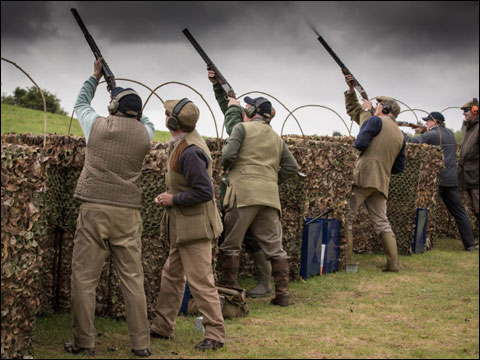 A line of guns practicing driven targets at the E.J. Churchill Shooting Ground.
A line of guns practicing driven targets at the E.J. Churchill Shooting Ground.As Purdey’s George Juer had told me in December 2018, “This gun was four years in the making – the bulk of it included more testing than the norm,” he said. “We put more than 150,000 cartridges through it to prove that it can meet the challenges of changing shooting styles of higher birds and higher volumes of heavier loads.”
My introduction to the Digweed Method started with a chandelle. Mr. Davies characterized the Digweed Method as a variation on swing-through. While the Churchill Method minimizes the notion of target lead, the Digweed Method likewise says it’s irrelevant.
To start, your feet point in the direction of the breakpoint. Then you wind your body back to slightly behind the focal point where you first “visually pick up the target,” said Mr. Davies. Call pull, focus on the leading edge of the target and then pull the trigger.
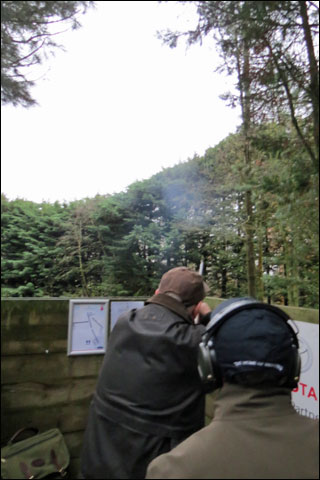 The author, with instructor Adam Davies behind him, getting the knack of the Digweed Method on a chandelle at the E.J. Churchill Shooting Ground.
The author, with instructor Adam Davies behind him, getting the knack of the Digweed Method on a chandelle at the E.J. Churchill Shooting Ground.“Swing through the target to its front edge and pull the trigger,” he said. “It’s not lead that breaks targets, it’s gun speed.” In effect, the momentum of the swing, with the proper gun speed, inherently covers the correct lead. Bottom line: you don’t think about or calculate lead. After missing a few he advised “slow down, use your eyes.” Sure enough, I soon broke six straight.
Naturally, if you’re shooing an outgoer you can’t focus on the leading edge, but the message here is focus on the most important point of the target.
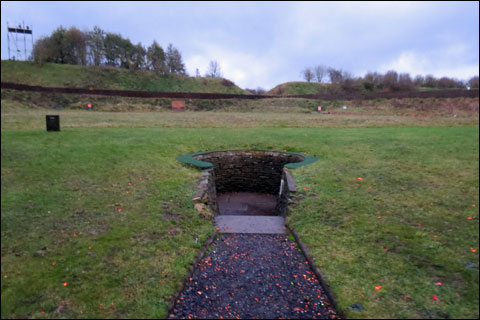 One of the grouse butts at the E.J. Churchill Shooting Ground.
One of the grouse butts at the E.J. Churchill Shooting Ground.Still, there was another sacred cow of British shooting history to be sacrificed during my lesson: Percy Stanbury.
Mr. Stanbury had developed his signature method for shooting high driven birds that was taught at the West London Shooting School, where we had been the day before.
The Stanbury Method advanced the art of shooting high driven birds. Mr. Stanbury had realized that when shooting skyward at pheasant, for example, most people arched their back, lifted their front foot, shifted weight to the rear foot and craned their neck – causing the head-lifting from the stock and loss of balance that would almost guarantee a miss.
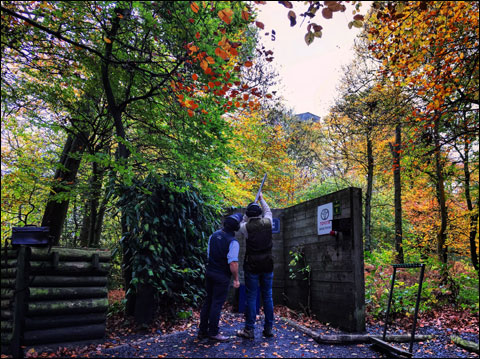 One of the sporting clays stands at the E.J. Churchill Shooting Ground.
One of the sporting clays stands at the E.J. Churchill Shooting Ground.Working with the West London Shooting School founder Richmond Watson, they determined that, contrary to popular wisdom, body weight should be on the front foot with the body at a slight forward angle. Feet are six-to-nine inches apart. The hips are forward and the rear heel raised a bit during the weight transference when starting to engage the high bird in a sweeping overhead shot. This address position requires a straight line from the front shoulder, down to the front hip, that continues to the ball of the lead foot. Ultimately, you’re constantly moving to face the target.
George Digweed, however, developed a different technique for high driven birds. Rather than face the incoming target, you stand perpendicular to it with feet stationed for even weight distribution, balance and corresponding with the flight line of the quarry. And instead of arching back, you bend at the waist, pushing out your lead hip, and use the other attributes of his swing-through method. As the bird approaches, shift your weight to the back foot while maintaining your shotgun along the line of the target. You push your forward-facing hip toward the approaching bird. The proper gun speed will supply enough target forward allowance to down the bird.
I can personally attest that Mr. Digweed’s manner for these types of targets is more comfortable and natural than Mr. Stanbury’s. Shooting at high incomers, my first attempts were off. Mr. Davies encouraged me to keep up the gun speed, and sure enough I started smashing them.
Like the Digweed Method, a trip to the E.J. Churchill Shooting Ground will rock your world.
Irwin Greenstein is the publisher of Shotgun Life. You can reach him at contact@shotgunlife.com
Useful resources:
The E.J. Churchill Shooting Ground web site
The Wingshooting Schools of England, Part 1: James Purdey & Sons’ Royal Berkshire Shooting School
The Wingshooting Schools of England, Part 2: West London Shooting School

Irwin Greenstein is Publisher of Shotgun Life. Please send your comments to letters@shotgunlife.com.


Comments